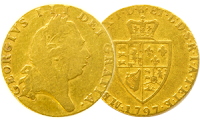...continued from the previous post //
 |
| Royal Mint Court in 18th century |
The year 1816 was a landmark for
British coinage. The mint was moved
from the Tower of London to a new site on Tower Hill and steam powered
minting machinery built by Boulton and Watt replaced the old hand
operated presses. Significantly, new coinage was produced with an
intrinsic value substantially below the face value of each coin - the
first official token coinage in the world.
 |
| Image courtesy oldukphotos.com |
In 1817, after an absence of 213 years, sovereigns were minted to
replace the guinea. The new coins, valued at 20 shillings (the same as
the original rate of over three centuries earlier), were accompanied by
half sovereign issues and pattern five & two pound pieces. All were
minted to the 22 carat (91.6%) fineness standard previously used for the Guinea coins.
Alongside
half sovereigns issued with the shield type
reverse, Bendetto Pistrucci's famous St. George slaying the dragon
design appears on the new sovereigns. Throughout most of the 19th
century, the Shield and St. George
reverse designs were interchanged on sovereign and half sovereign
coins, in many years both designs appearing for the same denomination.
The discovery of large quantities of gold in the Australian colonies in
the 1850's led to the establishment of the Sydney Branch of the Royal
Mint in 1855. The first 'Sydney Mint'
sovereigns and half sovereigns issued by this mint were unique in the
history of the British Empire. In a situation which has not been
repeated since, the coins carried a design which was completely
different from that of the standard British issue.
By 1871, the standard Shield and St. George designs had been decreed to
be produced by the colonial mints. A small 'S' mintmark was placed below
the shield to designate the Sydney Mint issues. On 'St. George' issues,
the mintmark appeared on the Obverse below the bust. The Melbourne Mint
commenced operations in 1872 ('M' mintmark) and Perth in 1899 ('P'
mintmark).
A Jubilee head design of Queen Victoria was placed on the obverse in 1887. Colonial 'S', 'M' and 'P'
mintmarks for 'St. George' gold coins were moved to the reverse on the
ground just above the date.
In 1908 (Edward VII's reign), the Canadian
Mint ('C' mintmark) at Ottawa began producing sovereigns. For a single
year in 1918, the Indian Mint ('I' mintmark) at Calcutta produced a
sovereign. The last of the colonial mints to issue gold coins - Pretoria
in South Africa ('SA' mintmark) - began producing sovereigns and half
sovereigns in 1923 (George V's reign).
Britain's last circulating sovereign issues were dated 1925 and in 1932,
the last of the colonial issues were minted in South Africa. A gold £5,
£2 & Sovereign (£1) set was prepared for Edward VIII but his
abdication on 10th December, 1936 ensured that they were never issued.
Proof £5, £2, Sovereigns (£1) and Half Sovereigns (£½) were issued to
commemorate the coronation of George VI in 1937. A small number were
minted in 1953 for Elizabeth II's coronation but they were not issued
for collectors.
 |
| 500 Years Sovereign Anniversary Tudor Rose £5 coin |
In 1957, Great Britain resumed the issue of sovereigns for the bullion
and collector market. In 1989, 4 specially designed gold coins (£5, £2,
£1 and £½) were issued to commemorate the 500th
anniversary of the Gold Sovereign.
Other countries to issue gold Sovereign coins and it's derivatives include:
- Andorra - Sovereign issues in 1982 and 1983,
- Gibraltar - Quarter, Half, One, Two and Five Sovereign issues in 1989 and 1990, and
- Isle of Man - Half, One, Two and Five Sovereign issues since 1965.
Article source: australianstamp.com







